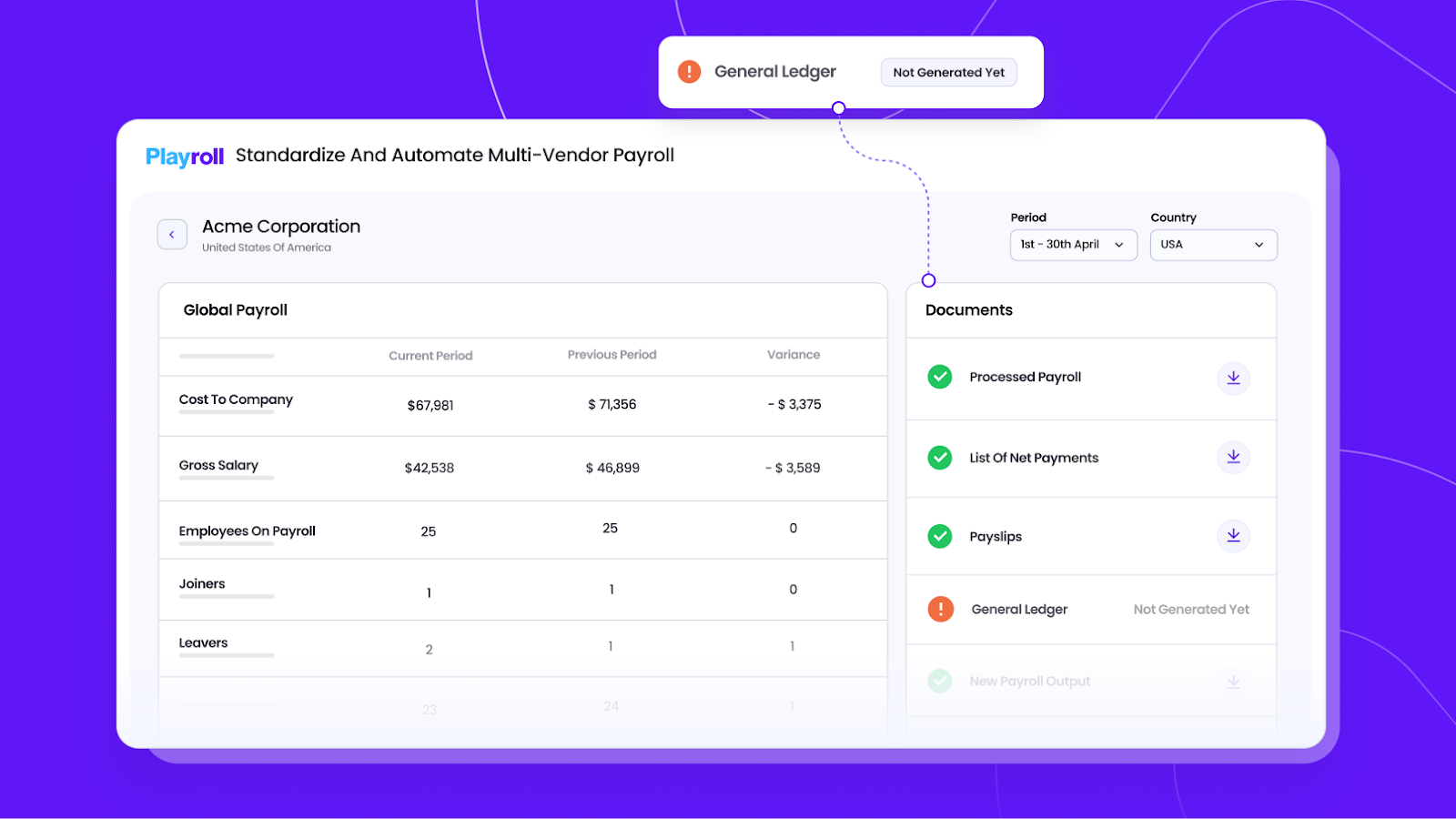Copied to Clipboard
Ready to get Started?


Key Takeaways
Employees cost 25–40% more than their salary once benefits, payroll taxes, and overhead are factored in, meaning a $60,000 hire can easily cost closer to $80,000.
Hidden costs like recruiting, onboarding, equipment, and turnover can significantly increase total employment expenses, especially for small businesses.
Using an EOR like Playroll can save $15,000–$20,000 in entity setup costs and streamline compliance, payroll, and benefits across 180+ countries.
Hiring new talent is one of the most exciting – and expensive – parts of running a business. But if you’ve ever wondered “how much does an employee cost?”, you already know the answer is far more complicated than “whatever’s on their paycheck.”
Today, U.S. employers spend an average of $45.65 for every hour worked per employee. But only 70% of that goes to wages and salaries. The other 30% covers benefits, payroll taxes, and legally required contributions. There are considerable additional costs over and above what an employee earns and what they actually cost.
Understanding the true cost of employment is critical for small businesses and enterprises alike. Underestimating can leave you short on budget, limit your ability to scale, or put you at risk of compliance penalties. This guide breaks down every cost component (direct and hidden) so you can plan ahead, avoid surprises, and hire confidently.
Direct Employee Costs: Salary, Benefits, and Taxes
When most employers think about cost, they stop at salary. But the direct costs of employing someone include more than just base pay. Benefits add up to 30% of compensation and mandatory payroll taxes typically add 8-10%. Together, non-wage costs and wage costs can push your total employment costs to 25-40% above a hire’s actual salary.
Direct costs are non-negotiable, meaning you can’t legally skip payroll taxes – plus, competitive benefits are essential to attract and retain talent. It pays to understand the balance between the three pillars of salary, benefits and taxes. That way, you’ll have a clear picture of what it truly costs to keep your workforce running and retain your team in the long run.
Let’s look at each one in detail.
Salary
Salary is the visible part of employment costs. It’s the number you negotiate and the one your employees see on their offer letters. But while salary forms the foundation, it doesn’t capture the bigger picture of cost to employers.
Take a mid-level software engineer in the U.S. earning $110,000 annually. On paper, that looks straightforward:
- But once you add benefits (≈30%)
- Payroll taxes (~8–10%),
- And indirect costs (equipment, onboarding, overhead)
The true cost to the employer is closer to $160,000 annually. That’s nearly 50% more than the salary alone. This is just an illustrative example, but it reflects the reality that salaries often underestimate actual employer spend by 25–40%.
Employee Benefits
Employee benefits are the “hidden engine” of employment costs. Health insurance alone is a major expense. In 2025, annual family coverage for a family of 4 surpassed $35,000, with employers covering around 58% – or $24,000 per employee. Add in retirement contributions, PTO, and fringe perks, and the costs multiply quickly.
Well-structured compensation packages matter here. Benefits not only drive costs, they also influence retention, employee satisfaction, and productivity. A company that trims benefits too aggressively might save in the short term but risks high turnover, and turnover is one of the most expensive costs of all.
Payroll Taxes
Payroll taxes are another unavoidable piece of the puzzle. If you’re hiring full-time employees, you’re responsible for a range of contributions that directly add to the cost of every hire. You might also be eligible for certain tax credits that can offset some of these expenses, depending on your county-specific laws and industry.
The example below is specific to payroll taxes in the U.S.
The big ones are:
- Social Security: 6.2% up to $176,100.
- Medicare: 1.45%, no cap.
- Federal Unemployment Tax (FUTA): Effective 0.6% on the first $7,000 in wages.
- State Unemployment Tax (SUTA): Ranges widely from 0.1% to as high as 12%, depending on the state and the employer’s history.
- Workers’ Compensation: Averages $0.90 per $100 in payroll but varies heavily by industry risk.
For a $60,000 salaried employee, these taxes can easily add another $5,500–$7,500 annually. And unlike benefits, which can be flexible, payroll tax obligations are fixed.
Indirect Costs of an Employee: Onboarding, Overhead and Equipment
Indirect costs are the ones that often get overlooked in the excitement of hiring a new team member. They don’t appear in the contract, but they’re very real and significantly impact the total cost of employment.
These costs cover everything that happens after your offer is accepted: recruiting, onboarding, equipping, and managing employees day to day. If you’re a startup or SMB, don’t forget to add these to your costing sheet. Otherwise, new hires can seem far more affordable on paper than they actually are in practice.
Let’s break them down.
Recruitment and Onboarding
Recruiting and onboarding are some of the most expensive hidden costs. Posting jobs, interviewing candidates, running background checks, and then training them into the role all take time and money. Each of these steps in the hiring process has a measurable effect on overall costs.
The average cost to hire an employee in the U.S. is roughly $4,700–$5,200 annually. That number can climb higher for specialized roles or positions requiring certifications. Add in the productivity lost during onboarding – it typically takes most new hires 8–12 weeks to ramp up fully – and the true cost of hiring rises even further.
Equipment and Tools
Every employee needs equipment to do their job effectively. At a minimum, that includes a laptop, but in the age of digital often also requires phones, monitors, specialized software, and licenses.
Hardware alone often costs $1,500–$2,500 annually per hire, while software subscriptions average $100–$200 per month per employee. Hybrid and remote teams bring additional costs, like shipping equipment, VPN security, and IT helpdesk hours.
Overhead
Overhead refers to the ongoing costs of supporting employees outside of pay and benefits. This includes HR administration, payroll systems, rent and utilities (for office-based teams), and employee engagement programs.
Turnover is one of the most expensive overheads. Replacing an employee can cost up to 33% of their annual salary, when you factor in recruiting, onboarding, and lost productivity. High turnover can silently impact employee costs – which is why investing in retention can reduce overall costs.
Playroll's Employee Cost Calculator
Getting a quick estimate of employee costs doesn’t need to be complicated. Our free Employee Cost Calculator lets you compare costs across multiple countries, share custom links with your team, and use the tool to model scenarios before making hiring decisions.
The Basic Formula to Calculate Employee Costs
If you want a quick, back-of-the-envelope estimate of what an employee will cost you, use this formula:
Total Employee Cost = Base Salary × 1.25–1.4
This multiplier accounts for payroll taxes and benefits. So:
- A $45,000 salary → $56,250–$63,000 annually.
- A $20/hour wage → $25–$28/hour true cost.
Keep in mind, though, that this doesn’t include recruitment, onboarding, training, office equipment, payroll costs, or turnover. For a more accurate picture, always add those additional factors in.
How to Calculate The Cost of an Employee
Although the above formula is good for an on the fly estimate, you’ll need to drill down into the details of what an employee will actually cost you before you go ahead and add them to your payroll.
Here's a step-by-step approach for how to do just that:
1. Determine Gross Pay
Start with the employee’s gross annual income before deductions. That’s the total amount an employee earns before taxes and deductions like benefits.
- Example: A mid-level Full Stack Developer in Austin, TX earns $110,000 annually.
2. Calculate Mandatory Payroll Taxes
Next you’ll need to calculate and deduct any federal payroll taxes from the gross annual income amount. As an employer in the U.S., you are legally responsible for several statutory contributions including:
- Social Security (6.2% up to $176,100): $6,820
- Medicare (1.45%, no cap): $1,595
- FUTA (0.6% on first $7,000): $42
- SUTA (Texas, 2.7% on first $9,000): $243
- Workers’ Compensation (average $0.90 per $100 payroll): $990
That leaves you sitting at with a total payroll taxes and mandatory contributions amount of
≈ $9,690 annually
3. Add Additional Employee Costs
Not that you’ve deducted all necessary state and federal taxes, you need to account for any benefits your company offers and indirect costs:
- Health Insurance (employer share, single coverage): ~$7,500 annually
- Retirement Contribution (3% match): $3,300
- Onboarding and Training: ~$2,500 (tech roles often require higher ramp-up costs)
- Equipment and Software (laptop, licenses, IT support): ~$3,000
Total additional costs: ≈ $16,300 annually
4. Calculate Total Annual Employee Cost
Now combine all components and you’ll have your true cost of employment:
- Salary: $110,000
- Payroll taxes: $9,690
- Additional costs: $16,300
Total Annual Cost Per Employee: ≈ $136,000 annually
How To Calculate Employee Cost Per Hour?
Once you’ve calculated your total true cost of employment, breaking the total down to an hourly cost is pretty simple. It’ll give an additional layer of understanding when it comes down to what a new hire really costs:
Step 1: Base hourly wage
- $110,000 ÷ 2,080 hours (40 hours × 52 weeks) = $52.88/hour
Step 2: Add all costs
- $136,000 ÷ 2,080 hours = $65.38/hour
Result: That $110,000 full stack developer actually costs the employer about $65/hour once payroll taxes, benefits, and overhead are included.
Employee Cost Variations Based on Location and Experience Level
Not all states, nor all employees will cost the same. Salaries, tax rates, and benefits expectations vary widely by region, making location one of the biggest drivers of employment costs.
Below is a state-by-state comparison of some of the most complicated state salary makeups:
Average Cost of Employees Based on Job Roles
Every role comes with a different cost profile. Salaries vary, but so do benefits expectations, tax implications, and overhead needs. Looking at average job roles gives you a clearer picture of what “total cost” really means and why it almost always exceeds the base salary by 25–40 percent.
Let’s take a look at four common roles in the U.S. workforce and their salary components:
Software Engineer
Tech talent remains one of the most expensive categories, especially in major markets.
- Base salary (U.S. average mid-level): $110,000
- Benefits (≈30% of salary): $33,000
- Payroll taxes (FICA, FUTA, SUTA, workers’ comp): ~$8,500
- Indirect costs (equipment, onboarding, overhead): ~$8,500
Total Estimated Cost: ~ $160,000 annually
Administrative Assistant
Support roles have lower salaries but still bring meaningful benefits and tax costs.
- Base salary: $40,000
- Benefits (≈30%): $12,000
- Payroll taxes: ~$3,100
- Indirect costs: ~$10,000 (equipment, workspace, onboarding, admin overhead)
Total Estimated Cost: ~ $65,000 annually
Sales Manager
Sales roles are unique because compensation often includes commission and bonus structures.
- Base salary: $90,000
- Benefits (≈30%): $27,000
- Payroll taxes: ~$6,900
- Indirect costs: ~$12,000 (CRM tools, travel, onboarding, turnover risk higher)
Total Estimated Cost: ~ $135,000–$150,000 annually
Retail Worker (Hourly)
Hourly employees bring different challenges — lower wages, but still subject to taxes, benefits (if full-time), and indirect overhead.
- Hourly wage: $20/hour (~$41,600 annually at 40 hrs/week)
- Benefits (≈25%, often leaner packages): $10,400
- Payroll taxes: ~$3,200
- Indirect costs: ~$4,800 (equipment, uniforms, training, turnover risk high)
Total Estimated Cost: ~ $60,000 annually (~$25–$28/hour)
Strategies to Reduce Employee Costs Without Losing Talent
Cutting costs doesn’t mean cutting corners. The fastest way to increase your costs is to trim so aggressively that you drive away talent or lose compliance. The smarter approach, particularly for small businesses, is to optimize. Reduce waste, rethink structures, and invest in areas that pay you back over time.
Here are four proven strategies to manage how your new hire will cost you, while keeping your team satisfied and engaged.
1. Hire Employees Through an EOR
If you’re hiring across borders, one of the biggest hidden costs is setting up and maintaining your own legal entity in every country. An Employer of Record (EOR) solves this problem by employing workers on your behalf, handling payroll tax compliance, benefits, and local regulations, freeing you up to focus on more strategic work.
- What it Saves You: Tens of thousands of dollars in entity setup and ongoing compliance costs.
- What it Prevents: Fines, delays, and administrative overhead.
- What it Enables: Faster hiring in new markets without legal risk.
Many employers assume EOR services are expensive, but in reality, the monthly fee is often far less than the combined legal, HR, and compliance costs of going it alone. On average, setting up a legal entity in a new country tends to cost $15,000-$20,000 in initial fees and setup costs. That’s not accounting for any compliance hiccups and additional hires you’ll have to make. Using an EOR like Playroll on the other hand will only set you back $399 per employee, per month. For a small or midsize company, this can make the difference between expanding confidently or stalling growth plans.
2. Optimize Employee Benefits
Benefits make up a large piece of the employee cost pie. But “large” doesn’t mean “inflexible.” Evaluating which benefits employees actually use, versus those they simply expect, gives you room to adjust without upsetting morale.
Actions to Consider Taking:
These action items are U.S. specific, but the elements that you’ll include in your employee cost calculation will likely be similar. If you’re looking at hiring in a specific country, we recommend having a look at our country- specific guides.
- Introduce high-deductible health plans paired with Health Savings Accounts (HSAs). These shift some cost burden to employees but keep tax advantages.
- Promote preventive care and wellness programs. You’ll see fewer claims and lower long-term healthcare inflation.
- Offer flexible or fringe benefits (e.g. remote work, childcare stipends, education allowances) rather than rigid, expensive perks everyone gets whether they value them or not.
3. Invest in Retention Programs
Turnover doesn’t just come with the headache of recruiting and training new hires, it completely disrupts teams, slows productivity, and costs real money. Replacing a good employee can cost up to a third of their annual salary, especially when you include lost institutional knowledge and ramp-up time. Employees want to see a future for themselves at your company. That’s something you can implement into your retention strategy in a few simple ways:
Retention Moves That Help:
- Set up clear career paths with visible promotions and pay raises. Employees are far more likely to stay if they can see what advancement looks like.
- Recognize and reward employee achievements regularly (not just at review time). Frequent, timely recognition builds loyalty and engagement more effectively than once-a-year reviews. Simple gestures like public shoutouts or small rewards can have more of an impact than you might imagine.
- Support flexible work / hybrid models. Flexibility is now an expectation, not a perk, and it’s proven to reduce turnover. Hybrid schedules or remote options give employees control while improving focus and satisfaction.
- Provide learning and development opportunities for your teams. If they see that you’re investing in their growth, they’re less likely to look elsewhere. Training budgets, mentorships, or certifications all send the message that their future matters.
4. Automate Repetitive Tasks
Administrative tasks may be necessary, but they’re also time-consuming, prone to errors, and expensive when done manually. Payroll mistakes, benefits miscalculations, or delays in performance reviews can all create compliance risks and seriously frustrate your team. Why not skip the risk all together and invest in a payroll automation tool?
Automation Moves That Help:
- Automate your payroll processing. Modern payroll systems handle calculations, deductions, and filings automatically, reducing costly errors and saving HR teams hours every pay cycle.
- Streamline your benefits enrollment. Digital platforms let employees choose and manage their benefits directly, cutting down on paperwork and minimizing administrative follow-up.
- Digitize your performance evaluations by automating reminders, forms, and tracking and your reviews will never be delayed again.
- Centralize compliance tracking. Automated alerts for tax changes or reporting deadlines help employers stay compliant without constant manual monitoring.
Top Tools to Master Your Employee Budget in 2025
Managing employee costs is a balancing act, but with the right tools, it becomes far easier to plan, budget, and stay compliant. Here are three platforms that stand out in 2025, each serving a different type of business need.
Playroll: Best for Global Hiring and Compliance
Playroll’s global payroll manager gives you instant insight into payroll costs per region in one centralized dashboard, helping you understand the true cost of every hire across 180+ countries. Beyond visibility, Playroll offers variance analysis to catch payroll mistakes early and ensure compliance, reducing the risk of costly errors.
The platform also syncs seamlessly with your existing vendors and in-house systems, so you can manage salaries, taxes, and benefits without any disruption to your team’s workflow. As an EOR, Playroll handles compliance, payroll, and contracts – making international hiring faster, safer, and far more cost-effective than opening local entities.

Gusto: Best for Benefits Administration
Gusto is designed with small and midsize companies in mind. It combines payroll, employee benefits, and tax filing into one easy-to-use platform. If you’re hiring domestically and want to automate payroll and HR admin without needing a full in-house HR team, Gusto is a cost-efficient choice. If you’re hiring globally on the other hand, you might find the platform a bit limited.

QuickBooks: Best for Finance-First Teams
QuickBooks Payroll integrates directly with QuickBooks accounting, giving finance teams a single view of payroll and overall cash flow. It automates paycheck calculations, tax withholdings, and compliance filings, while keeping your financial reporting accurate and up to date. This makes it especially valuable for companies that want payroll tightly tied to accounting. If you’re a bigger company, however, you might find the lack of advanced HR and workforce management tools are a bit of a roadblock.

Take Control of Employee Costs With Playroll
Expanding into new markets doesn’t have to come with the steep price tag of setting up legal entities, local payroll systems, or in-country HR teams. With Playroll as your Employer of Record, you can hire internationally without taking on those fixed costs.
Yes, there’s a monthly service fee – but it’s a fraction of what you’d spend on entity registration, compliance management, and ongoing administration. You also avoid months of setup delays, meaning you can start operating in new markets almost immediately.
Depending on your strategy, you’ll also save on hidden overheads: maintaining a physical office, paying local payroll vendors, or juggling compliance requirements across jurisdictions. Playroll takes care of all of it, from payroll and taxes to contracts and benefits, so you can focus on building your team and growing your business. Book a demo with our team today to get started.
Employee Cost FAQs
How much does it cost to hire staff?

.png)
The short answer: more than the salary you advertise. In the U.S. benefits and payroll taxes add another 25–40% on top of base pay, meaning a $60,000 employee could realistically cost closer to $78,000 once healthcare, retirement contributions, Social Security, Medicare, and unemployment taxes are included. Add indirect costs like recruiting, onboarding, and equipment, and the total “cost to employer” climbs even higher.
Are there hidden costs when hiring an employee?

.png)
Yes, there are hidden costs when hiring an employee? They often surprise business owners. Beyond wages and benefits, you’ll need to budget for recruitment fees, onboarding and training time, work equipment, software licenses, and overhead like office space or HR administration.
High turnover is another hidden expense you need to watch out for. Replacing an employee can cost up to a third of their annual salary. Factoring these costs upfront gives you a more realistic picture of your employment budget.
Is hiring a freelancer cheaper than a full-time employee?

.png)
In the short term, freelancers often cost less because you’re not responsible for payroll taxes, health insurance, or retirement contributions. But hourly rates for skilled freelancers are usually higher, and you trade off consistency, loyalty, and long-term productivity.
Full-time employees come with higher upfront costs, but they often deliver better retention, institutional knowledge, and cultural alignment. The right choice depends on your growth goals and the stability you need.
What tools can help me budget for employee costs?

.png)
Playroll’s free Employee Cost Calculator is a great place to start. It gives you an instant breakdown of salary, employer taxes, and benefits in over 180 countries, helping you compare the “true cost” across markets. Pair that with Playroll’s salary benchmarking tools and payroll management platform, and you’ll have everything you need to budget accurately, stay compliant, and hire confidently.
.svg)
.svg)
.svg)

.svg)
.svg)




.png)


.svg)















.svg)